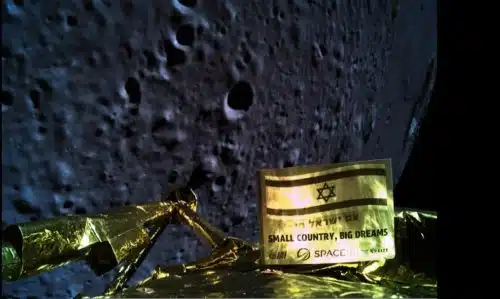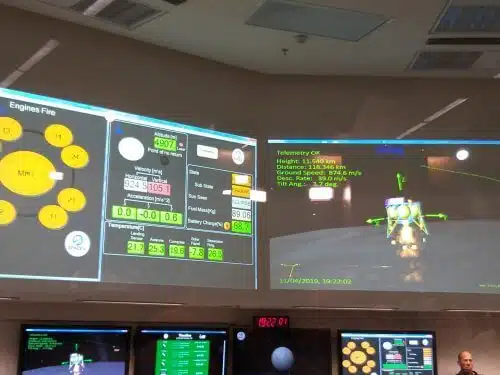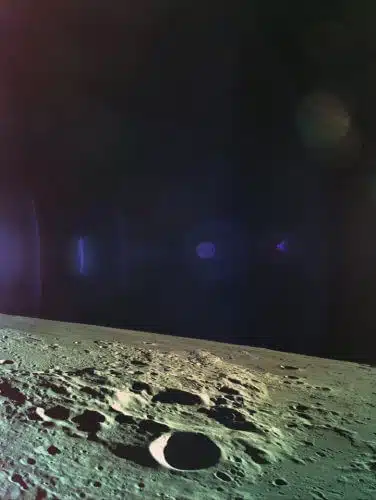The spacecraft's accelerometer stopped working at the wrong moment, and the spacecraft's engine shut down. The spaceship continued to spin and crashed on the moon at high speed, probably disintegrating into many parts

A sad ending: the Genesis spacecraft crashed on the moon about ten minutes before it was supposed to land on its surface. Eight years of preparation, seven weeks of a 7 million km journey in space, at the decisive moment, about ten minutes before it was about to land on the moon, the Israeli spacecraft crashed on the surface of our galactic neighbor. A small consolation was that the spacecraft managed to send two photos it took during its descent, one of which was a selfie of itself against the background of the lunar surface and the other a photo of the area where it was supposed to land but finally crashed into.
Until a quarter to ten, about ten minutes before the planned landing, everything went smoothly, and then suddenly the trouble began - the IMU device containing an accelerometer and which was supposed to report to the spacecraft's computer when it reaches the desired altitude for the engine to be activated, and in the position where the spacecraft is in the position where the engine is at the bottom of the spacecraft because The moon failed at the crucial moment. As a result, the engine stopped working and the Beresheet spaceship began to free fall on the moon from a height of 10 km, at an enormous speed, about 400-500 km/h.
Ofer Doron, director of IAI's space plant, said at the press conference held shortly after the incident that "after an initial examination of the data, it appears that one of the dimensions of the acceleration was a chain of events that led to the engine shutdown and failure. We made it to the moon, but not in one piece. Great pain alongside tremendous success." From the investigation it emerged that the spaceship began to free fall from a height of 10 km, apparently at a speed of 400 to 500 km/h."
The examination of the chain of events has already begun, with over a hundred SpaceIL and IAI engineers analyzing the data received from the spacecraft before contact with it was lost.
Prime Minister Binyamin Netanyahu, who arrived at the Israel Aerospace Industries control center, said before the landing process began, when everything was still in order, that he had decided to establish an Israeli space program. It is not clear what he means because Israel is a space power anyway.
Immediately after the crash, Netanyahu tried to encourage those present and said that it was an achievement. "If you don't succeed the first time, you try again," the prime minister noted. "The very experience is a great achievement. In two or three years, we will be the fourth country to land a spacecraft on the moon. Next time we will do it more gently."
Netanyahu, in his words, tried after the crash to start negotiations with the chairman of the SpaceIL association and the main donor to raise money for the follow-on spacecraft. On the other hand, the Google XPrize people posted a tweet on Twitter in which they pledged to give the first million for the benefit of the next Israeli spacecraft. According to Yonatan Besh, one of the founders of SpaceIL said in a conversation with the Hidaan site, that if a budget is found, the construction of the next spacecraft will take about a year and a half, when all the design is in place and it remains to manufacture the components again, and of course, to fix the necessary repair according to the findings of the malfunction.
Yonatan Weintraub, one of the three project initiators, said in a conversation with the Hadaan website: "We were ten minutes away from the nominal end of the mission. We saw that the vertical speed continued to increase while the horizontal speed had not yet finished zeroing, so it reached the ground at a speed of 900 meters per second, a very high speed and collided with it, the Israeli flag reached the moon, and also the photos that the children sent, but not in one piece."
Kafir Demari, another partner of the trio of founders, also said in an interview with us that it would be necessary to investigate the chain of events that led to the crash, and in any case, the operation was successful until almost the last moment, raising awareness of science studies among many youths, and showing the ability of Israeli engineers at a high level .”
Yariv Bash, the third partner in the founding of SPACEIL said that "we hope to learn more about the failures we had, and we will build a better spacecraft next time." Regarding the malfunction, Bash said that as soon as the accelerometer stopped working, it's like blindfolding someone and asking him to run straight, of course he wouldn't be able to, the spacecraft also couldn't continue navigating without the accelerometer."
The President of the country, Reuven Rivlin, who watched the moon landing with children at the President's House in Jerusalem, also spoke about the achievement and the Israeli technology that made it happen."

The President of the country, Reuven Rivlin, who watched the moon landing with children at the President's House in Jerusalem, also spoke about the achievement and the Israeli technology that made it happen."

The recording of the live broadcast of the planned landing, which at once became the broadcast of the crash event

20 תגובות
For "someone" - a spaceship for example is like a car. If someone were to build a car today from scratch without relying on the technological development of 150 years in the field of cars, they would at best end up with a faltering and very expensive car.
The same with the spaceship - the spaceil control team increased much more in salaries and working hours than an experienced team, ended up with a defective product and also did not complete the task.
Verbin: According to you, they could let NASA send a spacecraft and that's it, they already sent vehicles to Mars so they would surely have dealt with it. The idea was private non-governmental execution. Besides, using the knowledge of the aerospace industry means bringing in their own people and a certain ownership of the project. Avoiding this is not a mistake, these are very inefficient bodies at risk of collapse, military orientation and workers' unions, and this is in direct opposition to the purpose of the mission. There is no future for non-private space programs.
It is difficult to know whether the malfunction was due to relying on the meter data without redundancy (ie an incorrect algorithm that caused a software shutdown of the engine following an incorrect measurement), for this you do not need 2 units nor the knowledge of the aerospace industry. It is more likely that this is a technical fault in which a failure of the gauge caused the engine to shut down not as programmed. It's also reasonable in a joke that the computer started the engine - if the management of the information from the sensors receives wrong information it wouldn't help. But you can't tell yet
Guy: Communication is supposed to be Internet or other low rate packet switching, not analog radio like Apollo 11. There is no option for TV transmission, only file downloads
Kaman: There is almost no atmosphere on the moon.
Asker of the questions: No relation. The orientation was not correct due to the failure of the landing to proceed as planned following the technical failure of the gauge, the star tracker is used for non-inertial navigation in space not on the surface of the moon.
ES: Apparently, a general reset was done on purpose to the computer so that it would start the engine despite the gauge failure.
Meir Stern: If I understand correctly, your data are not contradictory. Since the movement is in two directions, 500 Kamesh is an approximate calculation of both for the downward speed per hour. But I would also appreciate a clear explanation
I didn't understand what happened to the spaceship crew, why aren't they being talked about? I don't care about the spaceship. previous human life
Even so, she couldn't go back because she ran out of gas
Did you send a RESET to try to activate the IMU2 that caused a general RESET to the system?
Or it just happened on its own, without the intervention of a control center.
If so, how did the controller try to manipulate the fault without permission?
And Rabin, do you know anything?
Hamas announces its involvement in the failure of the spacecraft..from a direct hit by a rocket..
They must have been there a long time ago...!
I don't understand why they didn't leave a camera running and broadcasting video during the landing. could understand what happened. Here they will not be able to find the black box and restore it.
Question: Is there a connection between the problem that was in the star tracker and the changes made to it and the effect on the accelerometer unit? From what I understand, the problem started with the orientation of the spacecraft, which caused a loss of communication.
It would have been possible to make do with a communication satellite around the moon with a 4k camera with high optical resolution
and sending small robots from the satellite to the ground to carry out research work
From the data that arrived at the time of the crash, I estimate from the spacecraft data that was broadcast, the spacecraft crashed at 22:23:02 at a horizontal speed of 946 meters per second or about 3400 km/h and a vertical speed of 134.3 meters per second. These are the last data that were transmitted and received at 22:23:01 at a height of 145 meters from the ground. In the time it took for the data to reach the Earth from the moon (about one and a half seconds) the spacecraft crashed on the surface of the moon when its fuel mixture apparently exploded. In my estimation, the fragments of the spaceship are scattered over many kilometers
Maybe an airbag would have prevented the crash....
In my opinion this is a software bug more than a hardware problem, but it is certainly possible that a helium pressure based engine is less suitable for part of a landing mission.
It is not clear to me why a parachute was not designed!
This is the best proof that during a flight it is forbidden to take a selfie!!!
There were two accelerometers in the spacecraft. Had the information been properly managed, a malfunction in one of the gauges could not have brought down the mission.
The planners did not invest in information management, as they were all completely inexperienced in controlling a satellite in space.
The Spaceil association consciously avoided taking advantage of experience in space control accumulated in the aerospace industry for 35 years, and this, in my opinion, is one of its serious failings.
Congratulations on this achievement! You learn from mistakes, and I'm sure they'll try again.
A nice allegory for the election results.
How much would it cost to build a replica of the spacecraft with the necessary repairs?
I saw a blue and white symbol on the spaceship that crashed, does that mean something?
Ihud Hatzla Spokesperson - Israel*
An accident involving a spacecraft happened on the moon.
Paramedics at the Yarah Branch Rescue Union provided initial medical treatment at the scene of the accident.
Eli Bir, president and medic of the rescue union who provided first aid at the scene of the accident said: "Together with the team of an intensive care vehicle, we provided first aid to the spacecraft when it was suffering from a multi-system injury.
Unfortunately, he was pronounced dead at the scene of the crash
For more information: Nachman Tobol, online spokesman for the Rescue Union